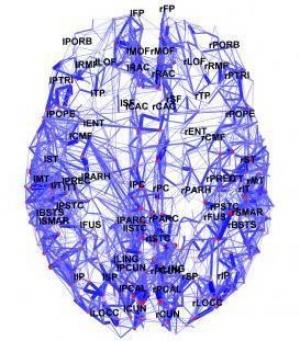Jul 02 2008
Connectomics and Brain Cores
Connectomics is the effort to completely map the neuronal connections of the human brain. It is akin to genomics – the mapping of the human genome, or its successor, proteomics – the mapping of the human repertoire of proteins. Connectomic has taken a huge leap with a newly published study that uses MRI techniques to map brain connections.
 An international team of researchers used a recently developed magnetic resonance imaging (MRI) technique known as diffusion MRI to image the pathway that bundles of neural connections take through the brain. Essentially, MRI scans use a powerful magnet to align protons in water molecules in tissues like the brain. It then uses a perpendicular magnetic field to push some of the protons out of alignment and then measure the radio signal that is created when the second field is turned off and the protons flip back. Different tissues have different water content and other properties that cause them to generate different MRI signals. MRI scientists have found numerous clever ways of manipulating this basic technique, in addition to improving the computers and software used to analyze the resulting signals, producing not only better MRI images but new ways of imaging brain anatomy and function. Diffusion MRI is just one of these special MRI techniques.
An international team of researchers used a recently developed magnetic resonance imaging (MRI) technique known as diffusion MRI to image the pathway that bundles of neural connections take through the brain. Essentially, MRI scans use a powerful magnet to align protons in water molecules in tissues like the brain. It then uses a perpendicular magnetic field to push some of the protons out of alignment and then measure the radio signal that is created when the second field is turned off and the protons flip back. Different tissues have different water content and other properties that cause them to generate different MRI signals. MRI scientists have found numerous clever ways of manipulating this basic technique, in addition to improving the computers and software used to analyze the resulting signals, producing not only better MRI images but new ways of imaging brain anatomy and function. Diffusion MRI is just one of these special MRI techniques.
What these researchers have done is use this technology to partially map major pathways and connections within the brain. One of the key findings is that there is a central hub within the brain containing the most connections – a brain core. Study co-author Olaf Sporns is quoted as saying:
“We found that the core, the most central part of the brain, is in the medial posterior portion of the cortex, and it straddles both hemispheres. This wasn’t known before. Researchers have been interested in this part of the brain for other reasons. For example, when you’re at rest, this area uses up a lot of metabolic energy, but until now it hasn’t been clear why.”
It has been known for a long time that the brain makes many internal connections with itself. It was also known that many of these connections were regional, while others were interhemispheric (between the right and left hemisphere). It was not known, however, that there is this central brain core. This will likely lead to some interesting research to discover the exact function of this central hub, or if it has a function beyond simply being a high traffic area.
This technique may also help efforts to reverse engineer the brain – to develop a computer model of an entire human brain, including all connections. We seem to be getting close to a perfect storm of science and technology – our understanding of brain function is playing off of our rapidly advancing computer technology, which is also playing into our increasing ability to map and model the brain, which is potentially feeding back into our computer technology. This is a technological feed-forward loop.
Hold on tight – it’s going to be quite a ride.






